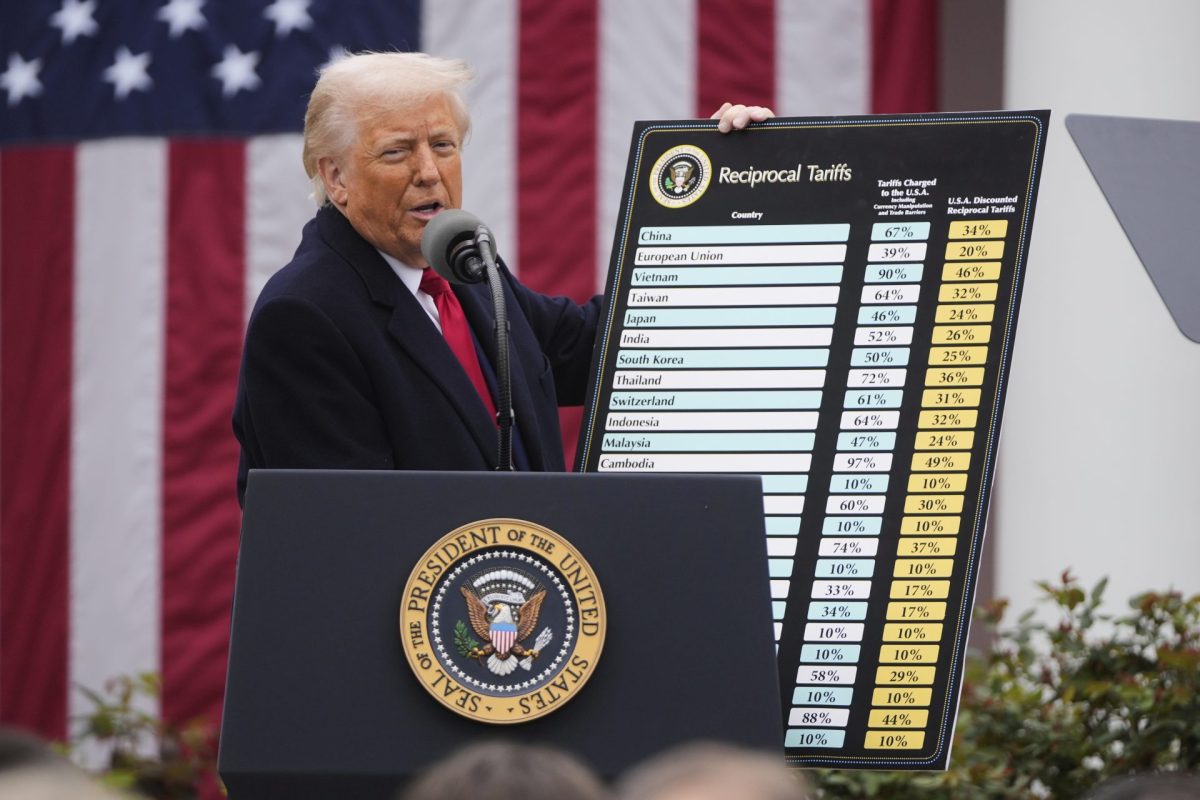Since April 2, a day deemed an economic “Liberation Day” by President Donald Trump, the administration’s tariff policy has continued to change by the day, if not by the hour.
“It’s very unsettling that there is no clear strategy, no negotiation process and no certainty about what will be the outcome,” Liliana Fargo, a DePaul economics instructor, said.
A tariff is a tax or fee that can be put on products imported into a country. Trump levied tariffs during his first administration targeting China. The Biden administration kept many of those tariffs on China in place and added some targeting electric vehicles in September 2024.
The big rollout rolls back … a little
Trump’s approach this time around is much broader:
- A baseline 10% tariff on imports from most countries and territories
- Slightly higher tariffs on Mexico and Canada with several exemptions pursuant to the US-Mexico-Canada trade agreement
- Reciprocal tariffs, which are added to the baseline 10% tariff, are specific to each country or territory and are calculated using a formula
On April 9, the administration modified its policy by placing a 90-day pause on reciprocal tariffs but raised tariffs on China.
Some tariffs have recently been modified to protect certain sectors like the auto industry and further exemptions have been made for products like smartphones and other electronics.
What’s with China?
There is a 145% tariff on most imports from China, with exemptions for products like pharmaceuticals and semiconductors.
However, the de minimis exemption for packages valued at or under $800 sent directly from China ended May 2. The administration cited “deceptive shipping practices” by companies that exploit the exemption to illegally ship synthetic opioids and fentanyl in its decision.
After confusion about whether tariff negotiations with China were really happening, Chinese state media reported May 1 that the U.S. has reached out to start negotiating, Reuters reported.
Reuters also reported that the Chinese government is developing a list of goods made in the U.S. that would be exempt from its 125% retaliatory tariff against the U.S.
Trump has said one of the goals of the tariff policy is to encourage American companies to make certain products domestically rather than in China.
However, American companies do not have many options in the short term to restructure their supply chains, according to Fargo, the DePaul economics instructor.
“They cannot really reallocate, overnight, that production to the local economy because we don’t have the capacity available at this point in the United States to replace what is done in China,” Fargo said. “It will take many years for companies to reallocate that production.”
The United States has become a service-oriented economy, Fargo added, and as a result, it may be easier for China to replace the products it imports from the United States.
Dispute over abuse of power
Twelve Democratic attorneys general, including Kwame Raoul of Illinois, have sued the Trump administration. They alleged that the president is overreaching his authority by using executive orders that “claim the power to increase tariffs without congressional action,” Raoul’s office said in a statement.
Congress has the primary power to levy taxes and tariffs, but the president also has authority to act alone under specific circumstances, such as under the International Emergency Economic Powers Act. This lawsuit disputes Trump’s use of this law, as do others.
Some U.S. senators, including a handful of Republicans, supported legislation to limit Trump’s actions on tariffs. But most Republicans opposed it. In an interview with Axios April 30, House Speaker Mike Johnson also said he would call the president if he thought he was overstepping his authority though didn’t deem that necessary.
Most Americans anticipate rising costs, have negative perception of tariffs
According to a Gallup poll released April 28, 66% of adults think it is “very likely” that tariffs will result in them paying more for the products they buy.
Ridley Timmons, a junior studying animation at Columbia College Chicago, said tariffs have affected the prices of paper and other art materials.
“As an artist, it is already extremely expensive to be in that specific craft, because all of our materials are from outside sources and from other countries,” Timmons said. “So increasing these tariffs is putting a lot of artists and just people in general out of business — and makes software and materials and pencils and paper just so much more expensive.”
DePaul does not directly choose which products are sold at campus stores, such as the ETC in Lincoln Park. But the university is “committed to working with vendors who offer the best possible pricing and service” to students, Kristin Claes Mathews, DePaul’s senior director of strategic communications, told The DePaulia in a statement.
As Americans continue to remain skeptical of the economic benefits of tariffs, the 90-day pause on reciprocal tariffs is set to expire July 9.
Editor’s Note: Micah Katzenmeier, a DePaulia contributing writer, contributed to this report.
Related Stories:
- Trump recommits to tariffs on Canada and Mexico, doubles tariffs on China
- How Trump’s order and the SAVE Act could stop you from voting
- What does Trump’s targeting of ‘woke programming’ in the arts mean for Chicago’s artists?
delivered to your inbox every Monday.
Support Student Journalism!
The DePaulia is DePaul University’s award-winning, editorially independent student newspaper. Since 1923, student journalists have produced high-quality, on-the-ground reporting that informs our campus and city.
We rely on reader support to keep doing what we do. Donations are tax deductible through DePaul's giving page.


